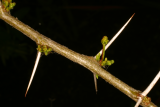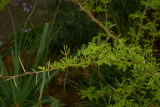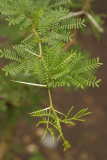Additional notes (click to expand)
Medicinal
A root infusion is taken by local people to treat pain in the alimentary canal, rheumatism, convulsions, gonorrhoea and as an aphrodisiac. Root powder is applied to penile sores for treating syphilis. A bark decoction is an emetic for treating diarrhoea.
http://www.pfaf.org,
Nomenclature
Acacia karroo is a synonym.
http://www.plantsoftheworldonline.org/
Other use
Acacia karroo Hayne – Sweet-thorn; Karoo thorn. Small tree. Distribution Southern Angola, east to Mozambique, south to South Africa. This tree is festooned with fearsome thorns, and, just before the rainy season starts, it produces poisonous sap; the slightest graze from a thorn at this time causes swelling and pain for several days. The bush people of the northeast district of Namibia use its sap in an arrow poison, adding it to the larva of Diamphidia – which is also poisonous. Its active ingredients are cyanogenic glycosides – which produce cyanide on hydrolysis. The bark contains tannins, which have been implicated in carcinogenesis. Acacia karoo produces Cape Gum, which is used in pharmaceutical preparations and to treat diarrhoea. Used to make rope from the bark, gum to make candy, fodder for animals, charcoal.
Oakeley, Dr. Henry F. (2013) Wellcome Library notes.
The gum is eaten as a confection. The roasted seeds are used as a substitute for coffee. Children chew the sweet thorns.
http://www.pfaf.org,
Geographical distribution
- Africa, South Tropical Africa
- Africa, Southern Africa
Vachellia karroo (Hayne) Banfi & Galasso
Family: FABACEAEGenus: Vachellia
Species: karroo (Hayne) Banfi & Galasso
Common names: Cape Gum Tree
Distribution summary: Africa
Hardiness: H7 - Very hardy
Habitat: Rocky areas in sparse forests, grassland and open bushland
Garden status: Currently grown
Garden location: Southern Hemisphere Wolfson bed (N)
Flowering months: June, July
Reason for growing: Medicinal


.JPG)
.JPG)
.JPG)
.JPG)
